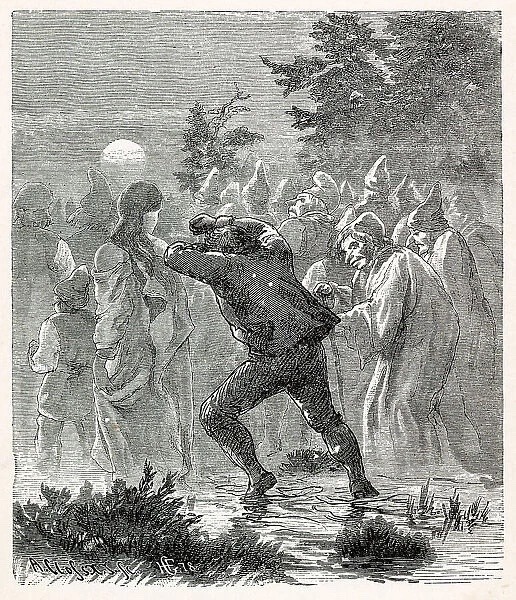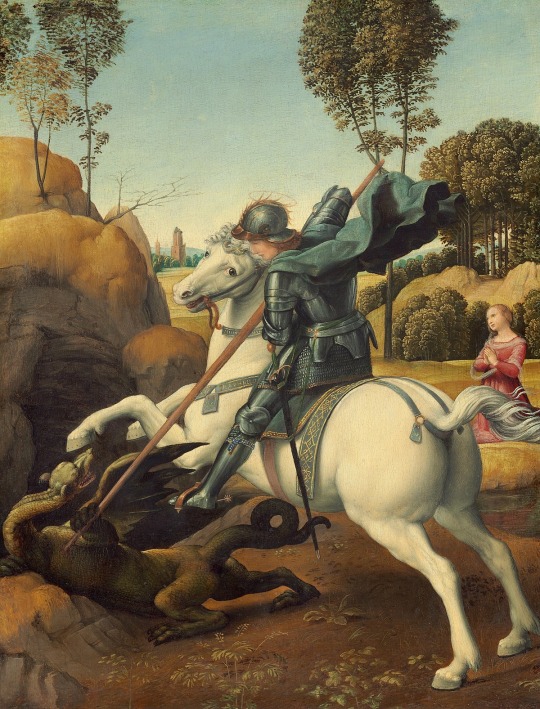Text
25th April
St Mark’s Day

Herbert Beerbohm Tree (1852-1917) as King John in King John by William Shakespeare. Source: Medium website.
Today is St Mark’s Day, the Evangelist of the Gospels. It is also the day in the thirteenth century when an infuriated King John, who found his royal regalia spattered by mud during a visit to Alnwick in Northumberland, inflicted a humiliating punishment on the local townsfolk for their poor upkeep of the roads. Every April 25th, the people of Alnwick were obliged to ride the roads and boundaries of the parish, taking the then difficult, and very wet, route through Freeman’s Well, a nearby pond. The boundary riders, forced to wear all white, the better to show up the dirt and mud they accumulated on their pointless ride, wielding swords and with night caps on their heads, had to dismount at the well, wade across it, then remount and carry on with their boundary ride. Extraordinarily, this masochistic tradition continued long after bad King John (who doubtless the whole business hilarious) had died.
In another tradition of St Mark’s Day divination, if you cast down a handful of ash, chaff or beans before your hearth after the last stroke of midnight, a mysterious footprint will appear in the scattering, belonging to your future love. Quite how you then identify your lover is left to you.
0 notes
Text
24th April
St Mark’s Eve

Source: Media Store House website
Today is St Mark’s Eve and sees significant supernatural happenings. The souls of those who are to die in the next twelve months go walkabout in their local churchyards tonight. The soon-to-be-deceased process mournfully around their church and the curious and ghoulish have been known to camp out overnight in order to watch the unhappy wraiths. For most watchers this was an exercise in morbid fascination but every now and again one of them would see his own phantom amongst the spectres and would find out the hard way that their days were numbered. The souls would gather in the church and then head off to their future graves before disappearing into the mist. Aside from the curious, those who wish to divine the future should also turn up to spy on the ghostly parade. If you peer through each window of the church in turn, the image of your future lover (happily not doomed to die in twelve months) will stare back at you from the last one.
In other supernatural goings-on on this spooky spring night, Satan is on the prowl in Willoughton, Lincolnshire. Horses will kneel and converse after dark and if you hide in the stable to overhear them, you will see Satan ride by, astride a black pig. The main reason the Devil is abroad tonight is to oversee the annual blossoming and seeding of fern.The speedy propagation of fern is therefore known as the Devil’s Harvest. Also, unsurprisingly, anyone born on St Mark’s Eve will be able to see spirits.
#english folklore#churchyard wraiths#st Mark’s eve#supernatural divination#satan#the Devil’s harvest#fern
1 note
·
View note
Text
23rd April
St George’s Day

St George and the Dragon by Raphael (1505). Source: Wikipedia
Today is St George’s Day. All that is known about George with any certainty is that he died on this day in Lydda in third century Palestine. He was rumoured to have quit the Roman army in order to practice his Christian religion and then travelled to Asia Minor where he came across a kingdom terrorised by a dragon who was demanding a regular feast of humans in return for not devastating the land. The victims were chosen by lot and eventually the king’s daughter herself was selected to be the dragon’s next meal. George rode to the damsel’s rescue and mortally wounded the beast with his lance but did not finish the creature off until George had extracted a promise from the king and his people to convert to Christianity. This clear fairy story made George a somewhat problematic saint which the church never took entirely seriously and it dispensed with him altogether in 1969. However during the Crusades, George became adopted by Richard I as patron saint of God’s soldiers and made his way with the returning Crusaders to England, becoming so popular that in the fourteenth century, Edward III made him England’s patron saint.
George soon replaced various spring pagan deities (the dragon being a symbol of winter) and began to feature in Christmas and Easter mumming plays as a killed-and-resurrected character. The dragon at least features on the 23rd during Norwich’s Mayor’s Day, as Snap, a decidedly pagan hobby-horse manifestation, leading the Mayor’s procession but being refused entry to the church. Snap would then wait on the so-called Dragon’s Stone for the duration of the service, menacing passers-by with his snapping wooden jaws. He liked to steal headwear, and lunged at schoolchildren who ducked and shouted ‘Snap, Snap! Steal a boy’s cap!’. The original pageant is no more, but a Snap costume, dating to the fifteenth century resides in Norwich’s Castle Museum and the procession itself has now transferred to July.
0 notes
Text
22nd April
Beer Tater Night

Source: Food and Wine website
This used to be the time of year for planting potatoes on what plain-speaking Sussex folk would call Spud Planting Sunday. It is thankless boring work, but was enlivened in that neck of the woods by the following evening, descriptively called Tater Beer Night, in which the health of the summer’s potato crop was toasted with copious amounts of ale. The farm workers pooled all their wages from the day to pay for barrels and barrels of beer turning the night into a cross between an old-fashion communal pub sing-song and a stag night. The more inventive the songs the better, and landlords would reward the best impromtu singer-songwriters with… more ale.
0 notes
Text
21st April
St Bueno’s Day

A stained glass image of St Beuno. Source: pravoslavie.ru
Today is St Bueno’s Day. Bueno was second only to St David in terms of being Wales’ favourite saint. He is associated chiefly with cattle, a result of the tradition of ritual cow slaughter at the well that bears his name in an openly pagan spring practice. In time, this evolved into the donation of cash to St Beuno’s Chest if any calves were born with physical disfigurement. The oaken chest itself is cunningly wrought to be an integral part of the church at Clynnog. St Bueno’s Well is also curative, particularly for those afflicted with epilepsy whose disease will disappear if they bathe in its waters.
In 2024, today is also the beginning of the Jewish feast of Passover, a commemoration of the last of the plagues visited on the Egyptians, namely the Angel of Death visiting their homes and taking off their firstborn. The Hebrew households were left unscathed, the Angel having “passed over” them. The Israelites were released from bondage by the Egyptian Pharaoh soon after.
0 notes
Text
20th April
The Hawkhurst Gang

Kingsmill Leading the Raid at the King’s Customs House. Source: Wikipedia
The Hawkhurst Gang were an eighteenth century group of smugglers, based at Hawkhurst in Kent, and who branched out into fully-fledged banditry. The gang terrorised the south of England from the Isle of Sheppey to Poole in Dorset, unleashing a campaign of extortion, robbery and murder. They seemed immune from the authorities and behaved like an unholy cross between the organised crime of the Mafia and the lawless psychopathy of the American Wild West, extending their murderous activities into piratical raids on towns. The gang infamously broke into the Royal Customs House in Poole in 1747 and relieved it of all the produce and goods they could find there. The gang was led by an unpleasant individual known as Richard Kingsmill, one of three brothers who were the leading lights of the criminal enterprise.
A certain William Sturt, a former soldier, let it be known he was forming an anti-outlaw private militia in Goudhurst in Kent and declared the town a no-go area for the Hawkshead Gang. On this day in 1747, Kingsmill responded by declaring his desperadoes would wipe out the Goudhurst militia and would boil the hearts of four of the townspeople and eat them for his supper for their impudence. Sturt the meantime had trained and armed his volunteers so when the inevitable Hawkshead attack came, he was ready. The gang charged into the town as was their wont, but were met by a concentrated volley of musket fire that devastated the outlaws’ ranks and killed Richard Kingsmill instantly. Three other attackers were slain and many others were wounded or captured. The Hawkshead Gang never recovered and the remaining members were hunted down. The two surviving Kingsmill brothers were eventually hanged at Tyburn. Sturt ended his days as Warden of the Gourdhurst Workhouse.
0 notes
Text
19th April
St Alphege’s Day

The Martyrdom of Alphege, Easter Day, 1012. Source: Alamy Stock Photos
Today is St Alphege’s Day. Alphege was Archbishop of Canterbury during the reign of King Aethelred the Unready, and was a major political figure at the English court in Winchester. The latter part of Aethelred’s reign was dominated by successive Viking attacks that his corrupt and ineffective regime could only partially control by bribery. In 1012, Alphege was captured during a Viking raid on Canterbury and he was carted off to Greenwich by the Scandinavians who hoped that Aethelred would pay handsomely for the safe return of his leading churchman. This was not to be. One night the frustrated Northmen dragged Alphege into their dining hall and, drunk, they began to pelt the bishop with ox bones, eventually killing him. The murderers initially refused to release Alphege’s body for burial, declaring that this would only happen when a dead piece of timber onto which his blood had spilled sprouted into life. Allegedly it did the following day, leading to the mass conversion of the raiders to Christianity and assuring Alphege’s sainthood at the same time.
On this day in 1824, the charismatic but ‘mad, bad and dangerous to know’ George Gordon, Lord Byron died. A promiscuous and bisexual bohemian, Byron scandalised early nineteenth century polite society but fascinated it too. He died of marsh fever in Missolonghi in Greece, characteristically trying to raise a volunteer army to help the Greeks win their independence from the Ottoman Turks. His ghost supposedly still swims the length of the Byron Pool in Grantchester, outside Cambridge.
0 notes
Text
18th April
Mary Parish

The Magical Adventures of Mary Parish by Frances Timbers. Source: Amazon.com
On this day in 1703, Mary Parish, perhaps the biggest conwoman in British history, died. Mary’s victim was Lord of Admiralty and Whig MP, Goodwin Wharton, who displayed the most extraordinary credulity when it came to her claims. Parish told him she could commune with angels, faeries, spirits and even God. Through her supernatural liaisons, Mary told Wharton, she could make his fortune and predict his future. Completely bewitched by Mary’s tales of fantastical contacts, Wharton displayed a limitless tolerance of her charms and predictions, despite virtually none of them working or coming to pass. Starting with low level good luck spells and charms (which never worked) Mary’s claims became more and more outlandish. She told Wharton the Queen of Faerie, who ruled a realm under Hounslow Heath, had fallen in love with him and despite twenty years of failed meetings with, and non-appearances by, the otherworldly monarch, Wharton’s faith in Mary never wavered. Eventually he and Mary became lovers and Parish told Goodwin that she became pregnant every time they made love (Mary was 53 by this time) but amazingly, despite 106 conceptions, poor Wharton never got to see any of his non-existent children, all of whom apparently died at birth, according to Mary.
Mary also assured Wharton she had enriched him by persuading the lovelorn faerie queen to leave him regular gifts of enchanted gold in his chest of drawers. There was however an inevitable catch. If Wharton ever tried to access the faerie treasure, the spell was broken and the gold disappeared before he caught sight of it. Wharton never doubted his ‘best of women’ even after her death. He was a fantasist and communer with the supernatural himself, so perhaps his willingness to be conned is explicable in that context. Mary must go down as one of the most clever and inventive tricksters the country has seen. Her strange story, contextualised by the sincere belief in magic in the seventeenth century, and the disadvantageous position of women at the time, is summarised by Frances Timbers in her book, largely derived from Goodwin Wharton’s own memoirs of his relationship with Mary.
0 notes
Text
17th April
St Donan and Companions’ Day

Celtic Woman Warrior. Source: Adobe Images
Today is Saint Donan and Companions’ Day. Although Donan was an Irishman, he joined St Columba’s mission on Iona before he and fifty two monks moved to the island of Eigg, west of Mallaig in the Scottish Highlands and established a new monastery there. The commune flourished and grew until the Easter Day of 618 (the 17th April) when Donan and his companions ran foul of a local tribe of Pictish women warriors. Their chieftainess nursed a grievance because the allegedly saintly Donan had swindled her and her people out of pasture rights on land the monastery had recently acquired. Armed to the teeth, these Gaelic amazons descended on Donan’s settlement while the community were celebrating Easter Mass, and captured all fifty three men alive. Donan and his followers were bound and herded into the refectory by the women who then set it alight. Donan and his companions were burned to death. Given the alleged paganism of the female warriors, the slain were later collectively canonised.
The story did not end there. While the Celtic amazons celebrated their easy victory and vengeance at their village later that night, a divinely-inspired spectral glow appeared in the sky. The chieftainess and her shield-maidens were all hypnotically drawn to follow the light, whose passage led them into a loch in which they all drowned. The loch, in the centre of Eigg is now known as Loch nam ban Mora, which is Gaelic for Loch of the Big Women.
0 notes
Text
16th April
St Magnus’ Day

Source: University of the Highlands and Islands website
Today is St Magnus’ Day. Magnus was a twelfth century Norse (Norwegian) Christian Jarl, who is supposed to have left his footprints on a flat stone at St Mary’s Church on South Ronaldsay island, when he miraculously used it to sail across the Pentland forth. Legend has it that Magnus was slain by King Hakkon of Norway, more for political reasons than for religious, by having his head cloven in two with a Viking axe, thus conferring instant martyrdom on Magnus. Although most of the stories associated with this warrior-saint are probably apocryphal, interestingly, in 1919 a skeleton was found, hidden within a pillar at Kirkwall Cathedral, Orkney, which is dedicated to St Magnus, whose skull was indeed split in two. Although there was no direct evidence linking the skeleton to Magnus, from that point on it was declared to comprise his remains.
On this day in 1646, at the battle of Culloden, Jacobite hopes were extinguished by George I’s Hanoverian troops’ decisive victory. Bonnie Prince Charlie went on the run after the defeat, eventually escaping to the continent. Apparently he had played cards on the eve of the battle, and the nine of diamonds fell from the pack and was lost. The Duke of Cumberland, the victorious Hanoverrian general, later found the missing card and used it to write his signature - the one to be used to sign Charles’ death warrant. The unlucky nine of diamonds was known as the Curse of Scotland thereafter.
#st magnus#hakkon of Norway#Kirkwall cathedral#bonnie prince charlie#Duke of Cumberland#battle of culloden#curse of Scotland
0 notes
Text
15th April
The Holy Well at Eigg

Source: Wikipedia
On the island of Eigg, off the west coast of Scotland, is a holy well dedicated to St Catherine. On this day islanders would gather to drink the water before marching sunwise around the well three times. This clearly pagan survival was challenged in the seventeenth century by the local Catholic priest, Father Hugh who dedicated the well to St Catherine. However, in an echo of his missionary predecessors a thousand years before, he allowed the islanders to continue their ancient practices that had their origins in older religions. The villagers would pile stones at the head of the spring as a communal penance before the priest held Mass. Father Hugh would hand out candles and his flock would then perambulate around the well, east to west, as they had in the days of pagan belief. This anti clockwise walk is believed to be a druidical charm to ward off evil spirits, and once performed, the neo-pagan Father Hugh declared the water sufficiently holy to be drunk.
Although the practice no longer takes place, 15th April is still considered a very propitious day to visit the well at Eigg.
0 notes
Text
14th April
First Cuckoo Day

Source: Bird Spot website
Today is First Cuckoo Day. Traditionally signalling that Spring has well and truly sprung, the return of this migratory bird to the U.K. after the winter, was generally held to bring good fortune to those that heard the first distinctive call of the cuckoo. However for the luck to apply, you have to be standing on soft ground, turn all your money out of your pockets and spit. If you are standing on hard ground, all good luck bets are off, which is probably why city dwellers don’t appear to benefit.
First Cuckoo Day marked the beginning of the Cuckoo Fair at Heathfield in East Sussex. The fair’s origin is allegedly down to Jesus (inexplicably wandering around southern England) asking one of his disciples to fetch him some bread. The local baker demanded payment, not unreasonably, but the disciple had none to give. However, the baker’s wife got their daughter to sneak Jesus a loaf. The grateful Messiah, in a deed straight out of Greek mythology raised mother and daughter to become the star constellation The Pleiades. He also, less generously, turned the baker into a cuckoo and decreed the bird would only be heard in the season of the Pleiades - roughly between mid-April and mid-June. The fair began in commemoration of these dubious miracles and continues to this day, although now it is little more than a church bazaar, complete with man in drag representing the baker’s wife and a pigeon disguising itself as a cuckoo.
0 notes
Text
13th April
Ann West’s Tomb

Source: Deborah Contessa on Facebook
On this day in 1803, Ann West died and was buried in Pembury Old Church, near Tunbridge Wells in Kent. Her tomb has a small hole in the side, a not uncommon precaution in the early nineteenth century when over zealous declaration of death led to the horrendous situation of comatose people being literally buried alive - Edgar Allen Poe’s gothic horror story was based on real events. Ann was particularly worried about this fate and specified that not only should her enclosed tomb have an air hole but that her coffin should be lidless and that bread and water should be placed next to her grave for twelve months after her supposed death. Fortunately for Ann, none of these precautions proved necessary because she turned out to be well and truly dead when interred.
The hole in the tomb however led to a macabre children’s game, in which kids would drop stones in the hole in order to hear them bounce of poor Ann’s skeleton. Whether it was this desecration that disturbed her ghost is not known, but Ann continues to haunt her former home at Great Bayhall Manor in Pembury, appearing as a white-clothed apparition or as disembodied footsteps. No supernatural vengeance visited on the annoying local children has been mentioned, however.
1 note
·
View note
Text
12th April
Maiden’s Garlands

An Eighteenth Century Maiden’s Garland On Display In Holy Trinity Church in Minsterley, Shropshire. Source: Shropshire And Beyond website.
On this day in 1747, Ann Howard of Ashford, Derbyshire, died aged 21. Ann was betrothed but unmarried and was therefore presumed a virgin which entitled her to the poignant tradition of having a Maiden’s Garland made in her honour. The garland, which was made out of of paper worked into the shape of flowers which in turn were arranged to give the garland a bell shape, was carried into the local church by a young woman the same age as Ann and then placed on the pew next to the deceased’s parents, where she would have normally have been seated: a heart aching act of community remembrance.
Maiden’s Garlands were once commonplace, and could sometimes be shaped as gloves or rosettes. Ann Howard’s garland can be seen still in the church at Ashford, marking the life a young woman who died too soon, still commemorated 277 years after her untimely passing.
0 notes
Text
11th April
St Guthlac’s Day

Saint Tormented By Demons. Source: Deor Reader website
Today is St Guthlac’s Day. Guthlac was as austere as they come which made him one of the most popular saints in pre-Conquest England, only really eclipsed by St Cuthbert. His toughness is perhaps explained by the fact Guthlac began life as a soldier before converting to the life of a monk. He joined the monastery at Repton but his aversion to sex and alcohol made him an outsider amongst the allegedly holy community in these days of pre-Benedictine monastic reform, so he left Repton for the bleakness of the Lincolnshire fens where he became a hermit, residing in Crowland, in those days only accessible by boat. Living a solitary ascetic existence, Guthlac’s only companions were a troop of demons who regularly tormented him, insulting the Saxon hermit in Welsh and generally making his life a misery. Guthlac was comforted by visits of angels and by his patron, St Bartholomew. It was the long-dead Bartholomew who equipped Guthlac with a whip with which to drive away the demons, and the whip then became the saint’s symbol.
It is said in Fishtoft in Lincolnshire that so long as Guthlac continues wield his scourge, the village will forever be free of rats and mice.
1 note
·
View note
Text
10th April
Kate Kennedy’s Procession

Source: Calendar Customs website
On this day in 1460, Bishop Kennedy of Edinburgh presented the St Andrew’s university college of San Salvator with a bell for its church tower. The bell was named Katharine, supposedly after the bishop’s niece. This led, so tradition claims, to the annual Kate Kennedy’s Procession, led by the St Andrew’s students. Despite its late fifteenth century alleged origins, the first records of the Procession only date from 1848, and it became a boisterous affair, and eventually so unruly that it was banned in the 1870s for fifty years. These days it is a fancy dress pageant, featuring characters from Scottish history aboard colourful flower bedecked floats. Despite her doubtful historical provenance, Kate Kennedy, usually played by a first year male student, leads the parade, accompanied by her “uncle”, a suitably vestmented fellow-student disguised as Bishop Kennedy.
The story of the bishop and the bell may be true, but the phonetic similarities of the Kate Kennedy Procession to the pagan rite of Cath Cinneachaidh, Gaelic for the ‘rebirth of spring’, hint at a more ancient origin of this April festival.
#Scottish traditions#st Andrew’s university#Edinburgh#San salvator college#Kate Kennedy procession#Cath cinneachaidh#bishop kennedy#pagan spring festival
0 notes
Text
9th April
The Drummer of Tedworth

Engraving of The Drummer of Tedworth. Source: LambethPalaceOnTwitter
On this day in 1661, John Mempesson, the owner of the Manor House at North Tedworth, Wiltshire, had William Drury, an itinerant drummer, arrested for vagrancy. Drury was incarcerated and Mempesson kept hold of his victim’s drum, which he stored in an upstairs room of the Manor House. The drum however, immediately became possessed by a poltergeist which became known as the Drummer of Tedworth. The haunting began with a military style beating on the roof of the house which soon spread to the walls indoors. Then the ghost turned to malign mischief, pulling sheets of beds, throwing articles of furniture around and attacking the Mempesson children. John himself chased the creature and confronted it under his bed where it panted like a dog at him. On other occasions the demon manifested as an apparition with glowing red or blue eyes.
On hearing of the haunting, Drury himself claimed responsibility and said he would only put an end to the poltergeist on condition of his release. Such understandable opportunism did Drury no good, because his offer was treated as a confession by the authorities and he was tried as a witch and transported to North America. Perhaps the unjustly treated Drury was telling the truth however, because the phantom drummer ceased his plaguing of the Mempesson family soon after Drury was sent away.
#english folklore#the drummer of Tedworth#manor house#poltergeist#ghost and hauntings#John Mempesson
2 notes
·
View notes